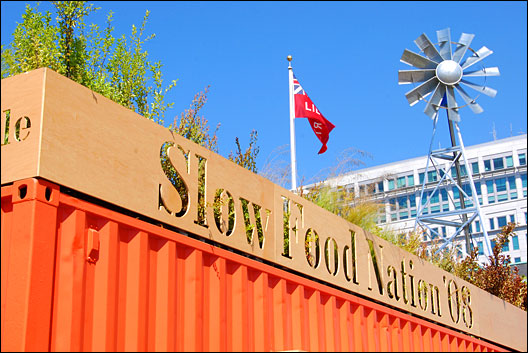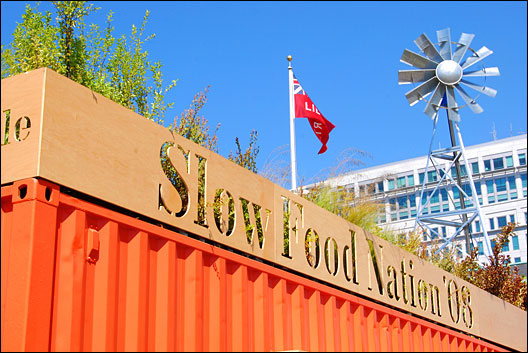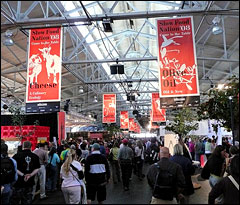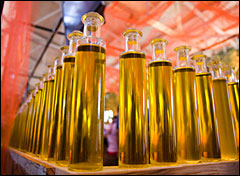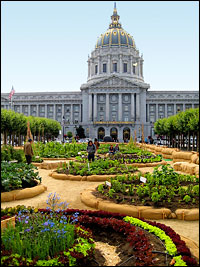Slow Food Nation — that grand, sprawling culinary event that seemed to permeate San Francisco over Labor Day weekend — has passed. Now we can ask: What was it? A brazen display of foodie elitism, as some critics charge? A transformative moment in an ongoing effort to overthrow the industrial food system, as its organizers sometimes hinted?
First, the grandeur of the gathering — organized by Slow Food USA — has to be acknowledged. Slow Food Nation’s Taste Pavilion, dramatically located at San Francisco’s bay-side Fort Mason, deserves a place in the history of U.S. food and design. Ensconced in a vast airplane hangar-like space, the pavilion offered rigorously “curated” — and stunning — selections of cheese, pickles, charcuterie, coffee, olive oil, liquor, chocolate, beer, fish, and wine. The interior design matched the quality of the food, each station conjured up gorgeously out of reused and reusable materials like wooden pallets and burlap coffee-bean bags and representing the vision of some of the Bay Area’s most creative architects. Meanwhile, the outdoor Slow on the Go market at the Civic Center presented a kind of perfect-world food court: huaraches as good as any I’ve had in Mexico City alongside fantastic coffee, terrific muffletas, killer ice cream, and much more.
The intellectual fodder on offer wasn’t bad, either. The event’s “Food for Thought” speaker series featured strictly A-list talent: Wendell Berry, Vandana Shiva, Eric Schlosser, Michael Pollan, Raj Patel, and more.
Further, more than any conference I’ve ever attended, the event exuded sheer ambition. In addition to the glories described above, Slow Food Nation included a lovingly designed and cultivated “Victory Garden,” a farmers market that embodied the sheer abundance of San Francisco’s celebrated foodshed, and, tucked into the teeming food court, a soapbox from which anyone who wanted could harangue the crowd. These features, I think, were meant to form a populist, accessible counterpoint to the pricy Taste Pavilion, food court, and star-studded panels.
Yet for all the activity and display of culinary, intellectual, and design skill, the question of what Slow Food Nation actually was hung over the event. At points, event leaders seemed to treat Slow Food itself, the international organization that formed in Italy in 1986 to protest a McDonald’s in central Rome, as the embodiment of the movement to challenge industrial food. From there, it was a short jump to presenting Slow Food Nation as a kind of watershed moment in the U.S. food movement — the point in time when public desire and political will for a new food system coalesced.
Meanwhile, on the ground, Bay Area residents grumbled about marginalization and elitism. When I first glanced at the prices for various functions, I thought they seemed reasonable, given that typical conferences run upwards of several hundred bucks for blanket admission. But then again, as a journalist, I rarely have to pay for conferences I attend. If I were a local resident without a professional tie to the event, would I have balked at $65 for the Taste Pavilion, or $25 to attend the flagship panel featuring Berry, Shiva, Pollan, Schlosser, Carlo Petrini, Alice Waters, and Corby Kummer? I guess it would depend on how tight my finances were. And that’s the point. While the public spaces at the Civic Center drew a reasonably diverse crowd, the for-pay events seemed uniformly white and well-off.
In the end, I think the vast ambition behind Slow Food Nation formed its weak point. By striving to embody and represent an entire movement — from “artisinal” food culture to urban agriculture — the event came off like a dreamer with his head in the clouds, disconnected from the struggle in the streets.
No one quite embodied that attitude like Alice Waters, doyenne of Slow Food USA, iconic figure of the sustainable-agriculture movement since she started her Chez Panisse restaurant in the early 1970s, and Slow Food Nation’s intellectual author. I adore Waters’ cooking style and respect her work as a pioneering restaurateur and school-lunch reformer; as a political spokesperson, she leaves me scratching my head. Asked at a pre-event press conference about the accessibility issue, Waters gave a riff about the Victory Garden and how it “represents our belief that good, clean, and fair food should be accessible to everyone all the time.”
Really? Beautiful as it is, the Victory Garden represents tremendous political, cultural, and financial resources. Slow Food Nation convinced the City of San Francisco to allow the garden to be installed on city land, got a prestigious landscape architecture firm involved in its design, and tapped a professional gardening company to help put it together. There’s nothing at all wrong with any of this, but Waters seems blind to her own considerable power — and unaware that other actors in the sustainable-food movement wield much less. And here’s the kicker: The Victory Garden is due to be demolished in November; the arrangement with the city is only temporary. The Victory Garden serves as a mighty symbol for the potential of urban public space to be both beautiful and highly productive; as a symbol of accessibility to “good, clean, and fair food,” it’s a bit of a farce.
But none of this negates the achievements of Slow Food USA or its flagship event. To become the relevant organization that Slow Food USA leaders seem genuinely intent on creating, the group may merely need to (of all things) slow down. Across the county, people of all kinds are challenging industrial food and working to create a more sustainable, just, and, yes, delicious food system. Rather than striving to be the movement around food, Slow Food USA might do better to consider itself part of a much broader and diverse movement.
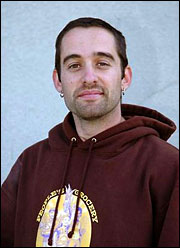
Brahm Ahmadi.
Whose Big Tent Is It?
Brahm Ahmadi, executive director of People’s Grocery in West Oakland, crystallized this idea in a recent (pre-event) post on his blog. Slow Food is “currently distracted by its own self-important belief that it should be a big tent for lots of people, rather than simply being an equal member of a much bigger movement or coalition in which the movement itself is the big tent,” he wrote.
Instead, Ahmadi argued, the group should “form coalitions in which Slow Food acts as an ally” to groups seeking to create socially just and sustainable food systems in low-income areas. For Ahmadi, that means not trying to speak for such efforts, but rather “leveraging its political and social influence to open doors and generate resources that other groups do not have access to.”
Slow Food Nation chose not to highlight the debate around the question of elitism and the food movement at its flagship Food for Thought series. But it did give Ahmadi a forum at its Changemaker Day forum — weirdly, an invitation-only event. Uninvited, I essentially snuck into Ahmadi’s panel on “Reframing the Slow Food Conversation to Support Food Justice.”
There, Ahmadi gave a salient example of his problem with Slow Food. Grassroots groups working in the Bay Area’s low-income sections like his own People’s Grocery had watched in awe and astonishment as Slow Food Nation and its impressive physical footprint took shape, Ahmadi said. The Victory Garden and the Taste Pavilion would be erected and dismantled in the span of a few months, representing tremendous efforts of top designers and artisans, to speak nothing of political muscle and financial resources. Meanwhile, groups like People’s Grocery struggle and wrangle for years to get a truck to deliver fresh food in West Oakland.

Josh Viertel.
Photo: Russ Walker
Joining Ahmadi on the panel was Josh Viertel, recently named president of Slow Food USA. I found Viertel’s answer to Ahmadi extremely encouraging. Rather than react defensively, Viertel encouraged the audience to read Ahmadi’s blog post. Then he admitted that Slow Food USA has a communication problem with low-income communities. He noted the group’s well-publicized effort to save heritage turkeys from extinction — a victory for biodiversity in our rapidly homogenizing food chain — but acknowledged the absurdity of touting such a victory in low-income communities where people will soon be choosing between buying enough food and paying the heating bill. Viertel seemed determined that Slow Food USA not “suck all the air out of the room” as the sustainable-food movement goes forward.
Viertel may seem an odd choice to rescue Slow Food from its elitist reputation. The group plucked him out of the leafy confines of New Haven, Conn., where he lead the Yale Sustainable Food Project. But broadening Slow Food’s focus is precisely his task. By any standard, “good, clean, and fair” food represents no more than 3 percent of food sold in the United States. To really challenge the status quo, the sustainable-food movement needs to expand its base dramatically — and Slow Food USA, with its considerable cultural and political stature, can be a constructive force in that effort.
Fast Food Nation author Eric Schlosser, a longtime Slow Food USA insider who was prominently featured at the Labor Day weekend event, is already providing an example. At forum after forum at Slow Food Nation, Schlosser drove home a key point: The millions of people who work at vegetable farms, meatpacking plants, and restaurants — the largest group of employees in the United States — are ruthlessly exploited and need to be included in any meaningful sustainable-food movement. And he stacked his own Food for Thought session not with celebrated authors, but rather with labor-movement leaders.
I heard Schlosser say off-stage that his single-minded focus on labor made him feel like a “turd in a punchbowl” at Slow Food Nation. In reality, such use of cultural capital is a torch lighting a path toward a truly just and sustainable food system.
Video interviews with Eric Schlosser, Brahm Ahmadi, and Josh Viertel will be coming to Gristmill soon.
